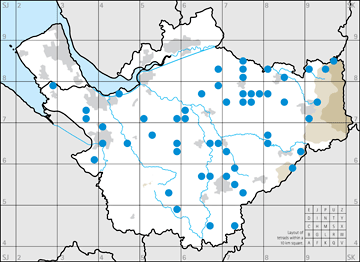
Jackdaws © Norman Richardson

Jackdaw roost map.
The winter Atlas map for Jackdaws is similar to that for the breeding season, with the main differences in the north of Cheshire and in Wirral. Some breeding tetrads are not occupied, but on the other hand, in winter, Jackdaws are found in a few sites in north Wirral and the Mersey valley where they did not breed, suggesting that their breeding distribution in the north of our area might be limited by a lack of nest sites. English breeding birds are sedentary – and on bright winter days in January some of them show signs of breeding behaviour – but some first-year birds might move south and west for the winter (BTO Winter Atlas). Although some immigrants from Scandinavia and the near continent have been found in eastern England, there is no evidence of any having reached Cheshire and Wirral (Migration Atlas).
Many of them undertake a shift in habitat for winter, with the proportion recorded in human sites halving to 21% as they slacken the association with potential breeding sites in buildings. Most Jackdaws in winter (58%, up from 34% of breeding season records) are on farmland, especially improved grassland, where they feed on seeds and whatever insects they can find, especially weevils, and small snails. One of the species’ specialised foods is ticks, picked from the backs of cattle and especially sheep. In urban areas they use their agility to reach into litter bins and other sources of food discarded by man.
Jackdaws are gregarious birds and usually found in flocks, often mixed with Rooks, from a few birds strong up to several hundreds, and John Headon estimated 2,000 birds near Adlington (SJ98A) in an area of improved grassland left to go to seed. The median count of Atlas records was only 20 birds, however.
One of the features of a late winter afternoon is the loud cackling of flocks of Jackdaws as they make their way to communal roosts. Roosts were recorded in 53 tetrads, as shown on the map. Half of the roost counts were of 50 birds or fewer, but some enormous gatherings were logged, with five of 1,000 or more, all in the east of the county. This is not a complete picture – for instance, a large roost in SJ58 was not reported – but would provide a good base for a thorough study of Jackdaw roosts across the county.
Sponsored by John Davies

